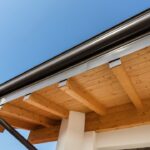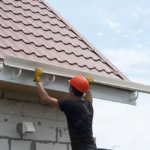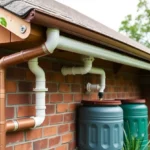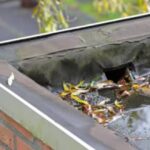When faced with the pesky issue of a leaky roof, homeowners often wonder where to even start. Fear not; it’s more straightforward than you might think to find a roof leak and address it effectively. Understanding the process and what to look for can save your home from water damage and your wallet from expensive repairs.

1. Understanding Roof Leaks
A roof leak is simply water seeping into your house, and it can originate from various sources, including broken shingles, damaged flashing, or blocked gutters. Genuine understanding begins with inspecting your roof regularly.
2. Signs of a Roof Leak
The first step is identification. Stains on your ceiling, peeling paint, or the growth of mold are classic indicators of a leak. Pay attention to these signs before they escalate into something bigger.
2.1 Water Stains
Sometimes, these brown spots on the ceilings appear randomly. They are usually circular and might grow bigger over time, pointing directly above it where the leak could be located.
2.2 Mold and Mildew
These thrive in damp conditions. If you see or smell mold, investigate further, as it might be burgeoning because of a hidden leak that needs urgent attention.
2.3 Drips and Puddles
Water pooling in your attic or along your walls is a sure sign. This needs immediate action to prevent further deterioration.
3. Outdoor Inspection: Safety and Tools
You’ll likely need a ladder, some gloves, and a pair of safety goggles. Walk your roof strategically, looking for lifted, curled, or missing shingles. Ensure you approach this task carefully to avoid any accidents.
3.1 Use Binoculars
For places you can’t reach or see, binoculars come in handy. Utilize them to spot anomalies from afar.
3.2 Check for Debris
Sometimes, debris lodged on your roof may cause water dams, leading to leaks. Clear these areas regularly.
4. Indoor Inspection: Detecting Water Damage
After inspecting the roof’s exterior, move indoors. Check your attic for signs of water penetration. Feel the insulation for dampness and follow the trail.
4.1 Follow the Water Trail
Water can travel in nifty ways. Trace it back from the visible spots on your ceiling to where it may be entering the attic.
4.2 Use a Flashlight
Dark spots in attics might mask trouble. A bright flashlight is indispensable in highlighting damp areas and potential leaks.
5. Utilize Technology in Leak Detection
With modern technology, detecting leaks has become more efficient. Infrared thermography, for instance, allows you to spot hidden leaks through thermal imaging.
5.1 Thermal Imaging Cameras
These cameras can highlight temperature differences in your roof, helping you spot the exact leaking point effortlessly.
5.2 Moisture Meters
Moisture meters accurately measure the moisture content in materials, particularly helpful in assessing the extent of water damage.
6. Temporary Fixes for Roof Leaks
Once discovered, it’s crucial to manage leaks promptly. Nail down a temporary fix, such as covering the area with a tarp if you expect rain before professional repairs.
6.1 Apply Roofing Tape
This is great for small leaks. Ensure the surface is dry and clean before application.
6.2 Use Roofing Cement
Spread roofing cement over the leaking area to prevent further water intrusion until a professional patch-up.
7. Seeking Professional Help
When do-it-yourself strategies fall short, or youre unsure, call in a professional. They offer expertise and equipment capable of diagnosing and fixing intricate leaks.
7.1 Hiring the Right Expert
Ensure they have proven experience. Authentic reviews and accreditations are good indicators of reliable professionals.
8. Preventative Measures
Regular roof maintenance is the most effective prevention strategy. Clean gutters, inspect your shingles bi-annually, and replace any damaged components immediately.
8.1 Gutter Cleaning
Clogged gutters cause water to back up and seep into the roof structure. Clean them regularly, especially during the fall.
8.2 Trim Overhanging Branches
These could damage your shingles during a storm, leading to potential leaks down the line.
9. Longevity of Your Roof
A sturdy roof gives you peace of mind. Regular inspections and prompt responses to potential leaks significantly enhance the lifespan of your roof.
10. Budgeting for Maintenance
Its essential to budget for bi-annual roof inspections and potential repairs. Such foresight helps to mitigate unexpected roof-related expenses.
10.1 Maintain an Emergency Fund
Emergencies occur, having a fund specifically for this ensures your finances arent strained unexpectedly.
11. Choosing the Right Materials
From asphalt shingles to metal roofing, choosing efficient materials determines the resilience of your roof.
11.1 Consider Material Lifespan
Select materials akin to your climate needs. [Link](https://roof-home.com/top-5-roofing-materials-a-guide-to-choosing-the-best-option-for-your-home/ ‘top roofing materials’)
11.2 Hire Professional Installers
Well-installed roofs by professionals lessen the chance of future leaks. [Link](https://roof-home.com/how-to-choose-a-roof-construction-company/ ‘Select roofing company ‘)
12. Impact of Weather and Drainage
Factors like windstorms, heavy rains, or hurricanes can damage your roof, impacting its integrity.
12.1 Cold Weather Damage
Snow and ice can lead to significant damage; ensure proper ventilation to counteract melting ice-related leaks.
12.2 Drainage Systems
Keep drainage systems well functioning to prevent water accumulation on your roof.
For further insights into roof maintenance, refer to this [detailed guide](https://www.bankrate.com/homeownership/cost-to-replace-roof/ ‘External Link’) for cost-efficient tips.
13. Importance of Warranty
A warranty acts as your safety net. Whether it covers repair costs, understanding your warranty ensures youre not caught off guard.
13.1 Coverage Scope
Understand whether wear-and-tear, catastrophic events, or material defects are covered.
13.2 Longevity
How long does it last? Ensure it corresponds to the expected lifespan of your roof.
14. Roof Replacement Options
Once your roof reaches the end of its lifecycle, be informed on your options for material, design, and professional help for replacement. Learn more here [Link](https://roof-home.com/what-is-epdm-roofing-a-complete-guide-to-this-durable-roofing-material/ ‘EPDM roofing’)
Explore various materials by reading [Link](https://roof-home.com/what-is-tpo-roofing-everything-you-need-to-know/ ‘TPO roofing’)
15. Conclusion and Next Steps
Identifying a roof leak promptly saves you cost and trouble associated with water damage. Regular inspections, maintenance, and utilizing technology will guard your home against future leak concerns.

FAQs
How often should I inspect my roof?
Twice a year plus after severe weather events. This ensures any damage is repaired before major issues occur.
Can a minor hole cause significant damage?
Yes, even small holes can lead to water damage which may impact your home’s structural integrity over time.
Whats the cost of roof repairs?
Depending on the extent of the damage and materials, repair costs can vary significantly. Consider budgeting a repair fund.For abditional information, visit Roof Repair Cost Guide.
This article contains affiliate links. We may earn a commission at no extra cost to you.







